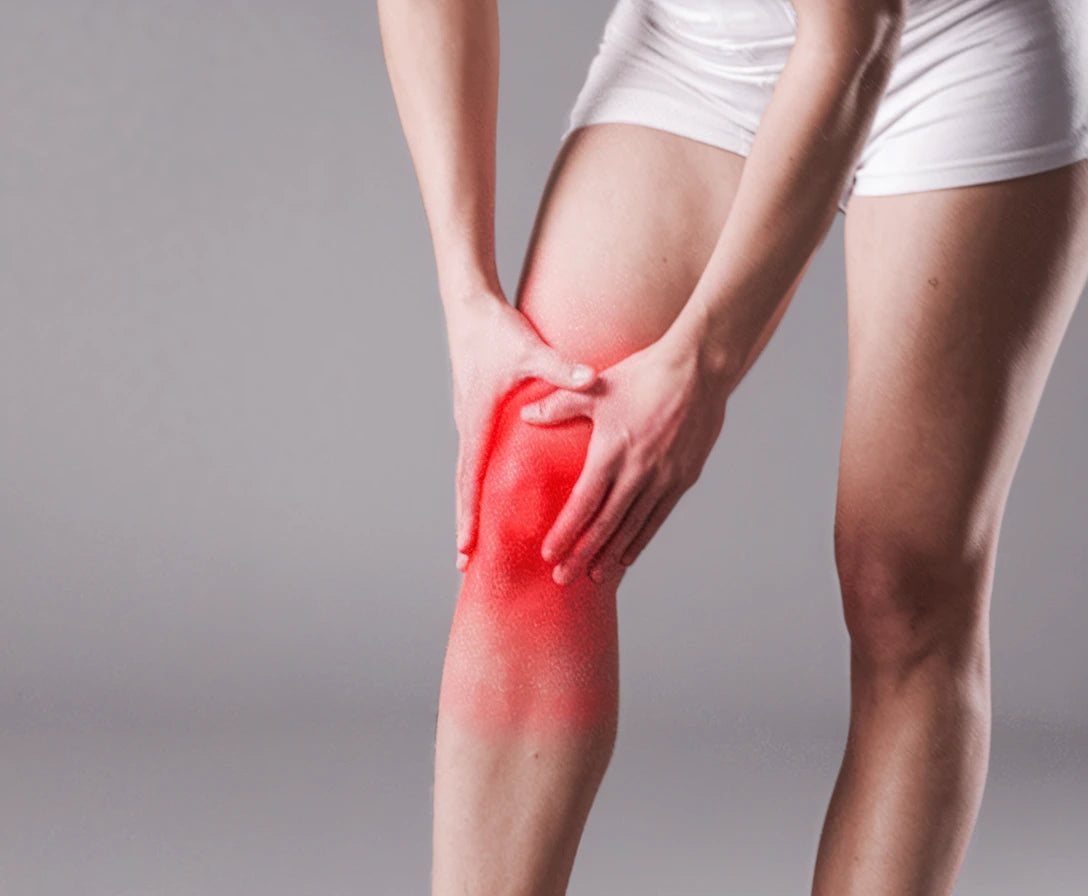PFSS - Patellofemoralt smertesyndrom: Symptomer, årsaker og behandling

Patellofemoral pain syndrome (PFSS) is a common knee condition that causes pain in the front of the knee, especially around or behind the kneecap. This painful condition can affect daily activities and exercise, especially during movements that put stress on the knee joint. This article reviews the symptoms, causes, and treatment options for PFSS.
Cause of PFSS – why does patellofemoral pain syndrome occur?
PFSS is a condition that affects the joint between the kneecap (patella) and the thighbone (femur), also called the femoropatellar joint. It is characterized by diffuse pain in the front of the knee joint and can affect people of all ages, especially athletes and young adults. PFSS is sometimes also called chondromalacia patellae, which refers to the softening of the articular cartilage at the back of the kneecap, although this is not always the case with PFSS.
People who frequently perform activities that involve bending their knees, such as running, weightlifting, or repetitive motions of the knee joint, are at higher risk of developing anterior knee pain. PFSS occurs when the articular cartilage wears down or when the movement of the kneecap against the femur becomes incorrect due to biomechanical factors, which are also often seen with knee overload.
People who frequently perform activities that involve bending their knees, such as running, weightlifting, or repetitive motions of the knee joint, are at higher risk of developing anterior knee pain. PFSS occurs when the articular cartilage wears down or when the kneecap's movement against the femur becomes improper due to biomechanical factors.
Symptoms of PFSS – what the pain in the front of the knee feels like
Common symptoms of PFSS include:
- Pain behind the kneecap or pain that feels like it comes from inside the kneecap
- Pain that occurs below the kneecap
- Increased knee pain during activities such as walking up stairs, especially downhill
- Pain when sitting with bent knees for extended periods of time
- Pain that occurs after sitting with bent knees for a long time
- Discomfort when squatting
- Knee pain after prolonged strain
- Stiffness and limited mobility in the knee
- The pain may worsen after physical activity
- Sometimes there is also pain around the kneecap.
Knee pain usually comes on gradually rather than suddenly, unless it is associated with a specific trauma. Many patients describe a feeling of instability or that the knee "gives way" when loaded, which can sometimes be mistaken for knee instability .
Causes of patellofemoral pain syndrome (PFPS) – biomechanics and overload
Several factors can contribute to the development of PFSS and the cause of PFSS can vary between individuals:
- Overuse of the joint between the kneecap and the thigh bone (femoropatellar joint)
- Incorrect movement of the kneecap against the femur
- Increased Q-angle in the knee, which affects the position of the kneecap
- Weakened thigh muscles, especially the front thigh muscle (quadriceps)
- Imbalance in the thigh muscles that affects the traction of the kneecap
- Anatomical factors that influence the biomechanics of the knee joint
- Foot misalignments, such as overpronation
- Weakness in hip muscles that indirectly affects knee mechanics
- Trauma or overuse of the patellar tendon
- Deficiencies in footbeds or shoes that do not provide enough support
Activities that trigger or worsen symptoms often include repeated squatting, running, jumping, or sitting with bent knees for extended periods, such as when going to the movies or traveling by car. Similar stress injuries occur in Schlatter's knee (Morbus Schlatter) , especially in young people.
Diagnosis and treatment of PFSS – how to find the right rehab and support
Diagnosis and treatment of PFSS – how to find the right rehabilitation and support
Patellofemoral pain syndrome (PFSS), also known as “runner's knee” or “anterior knee pain,” occurs when the kneecap does not move properly in its track. The pain is often located at the front of the knee and worsens when climbing stairs, squatting, or after prolonged sitting.
An accurate diagnosis and the right treatment will help you regain stability, reduce swelling, and return to activity without pain.
Physical examination
During an initial examination, a physical therapist or doctor will assess mobility, muscle strength, and knee joint stability.
Treatment: Rehabilitation training to strengthen the thigh muscles and reduce the load on the kneecap.
KnäKomforten™ provides compression that reduces swelling and promotes blood flow.
X-ray or MRI
Used to rule out cartilage damage or other structural problems.
Treatment: Taping of the knee to control the movement of the kneecap and relieve pressure on the joint.
KnäKomforten™ provides support during activity and relieves pressure on the knee joint.
Functional tests
Balance, strength, and movement patterns are tested to detect misalignments.
Treatment: Use of knee pads for PFSS to stabilize the joint.
KnäKomforten™ contributes to increased stability and support during movement.
Pain provocation test
Used to locate exactly where the pain occurs in the knee.
Treatment: Gradual return to activity in combination with rehabilitation.
KnäKomforten™ provides potential pain relief through compression and heat support.
Rule out other injuries
To ensure that the pain is indeed due to PFSS, tests are performed to rule out meniscus or ligament injuries.
Treatment: Correction of misalignment with shoe inserts or orthopedic aids.
KnäKomforten™ has a pad that provides extra support for the kneecap.

How Knee Comfort™ helps with PFSS – stability and relief for the patella
The Knee Comfort™ is a specially designed knee brace that can be an effective aid for PFSS by:
- Provide compression that reduces swelling around the knee joint
- Offer support for the knee joint during daily activities and exercise
- Contribute to increased stability in the knee through its unique design
- Contain a pad that helps control the movement of the kneecap
- Potentially reduce pain by relieving pressure on the patellofemoral joint
- Provide support during rehabilitation so that return to activity can be safer
- Improve the biomechanics of the knee joint during movement
Many users report significant improvement in knee pain when using the Knee Comfort™ during activities that would normally trigger pain, such as climbing stairs or during extended walks. For patients with conditions that also include knee bursitis , the support can be especially helpful.
Buy nowConclusion
Patellofemoral pain syndrome is a manageable condition with proper diagnosis and treatment. By combining rehabilitation exercises, supportive devices such as the KneeComfort™, and gradual return to activity, most people with PFSS can recover well. It is important to consult a doctor or physical therapist for an individually tailored treatment plan that takes into account the specific causes of your symptoms. This also applies to other common conditions such as osteoarthritis of the knee , which can have similar symptoms but different treatments.
Frequently Asked Questions (FAQ)
What is the difference between PFSS and patellofemoral syndrome?
PFSS and patellofemoral pain syndrome are essentially the same condition and the terms are often used interchangeably. Both refer to pain in the joint between the kneecap and the thigh bone.
How effective is taping for patellofemoral pain syndrome?
Taping can be effective in relieving pressure on the patella and reducing pain in many patients with PFSS. The technique helps correct the position and movement of the patella and can provide immediate pain relief for some patients.
What does Q angle in the knee mean and how does it affect PFSS?
The Q-angle is the angle between the thigh muscle and the patellar tendon. An increased Q-angle can contribute to the development of PFSS by affecting the movement of the kneecap against the femur, which can lead to overloading of the articular cartilage and cause pain.
Can I train with PFSS?
Yes, but it is important to adapt your training. Focus on exercises that strengthen the thigh muscles without aggravating the pain. Swimming, low-impact cycling, and specific rehab exercises are often recommended. Avoid activities that deepen squats and weightlifting until symptoms improve.
How long can I expect to use the Knee Comfort™ for PFSS?
The duration of use varies, but many people find it helpful to use the Knee Comfort™ during activities and exercise until symptoms have significantly improved. For some, this may be a few weeks, while others prefer to use the support for longer periods of time, especially during activities that previously caused pain.

